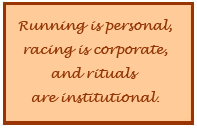The human body is an extraordinary self-renewal machine. It has been designed by God to constantly restore itself in such an efficient way that it is almost imperceptible. Each second, 10,000,000 cells die and are replaced with new ones and through this process one hundred hairs are replaced every day from our heads, our skin is made entirely new every month, our bone structure is totally replaced every three months, and even our nails grow from base to tip in six months.
The replenishing capabilities of our bodies are a bit more evident during physical exercise. When you run, your body goes through several stages of tiredness and renewal:
- From resting state to aerobic mode
- From aerobic mode to your personal mark
- From your personal mark to "the wall"
First, you experience the initial fatigue of taking your body from a resting state to the aerobic mode, when your heart rate increases and your breathing accelerate. Most inexperienced runners will stop at this stage, not allowing their bodies to adjust and provide them with the strength to run for a longer while.
Patience is the key to overcome this first stage of fatigue.
Reaching your personal mark
How long that while depends on how far you have trained. You will feel tired again to the point of quitting when you reach the highest number of miles you have ever run, or what I like to call your personal mark. Your body needs to reset your personal mark. In order to do so, you start with a small number of miles, let's say two, and continue adding distance to your run little by little.
Perseverance is the key to get past your personal mark and move the second stage of fatigue farther and farther.
Reaching "the wall"
No matter how far you reset your personal mark, the conditions of continued exercise will take you to the third point of heavy fatigue, known among distance runners as "the wall," normally reached around mile 20. During the aerobic mode, your body will produce the necessary energy in the form of glucose mostly from carbohydrates. When the carbohydrate reserve is totally depleted, your body readjusts to produce glucose from your fat stores. This process is much slower than that of burning carbohydrates, causing the energy levels to decrease rapidly for a while until your body makes the switch from carbs to fats; but fats can take you a lot farther than carbs.
Purpose is the key to overcome the wall and switch energy sources until you reach your finish line.
Running and not getting tired is physically impossible and yet our bodies respond with energy that surprises and enables us. In the same way, waiting with patience, renewing with perseverance, and soaring with purpose provide our race of faith with astounding strength. The Bible puts it this way:
“But they that wait upon the LORD shall renew their strength;
they shall mount up with wings as eagles; they shall run,
and not be weary; and they shall walk, and not faint.”
(KJV: Isaiah 40:31)
If you feel you have hit your wall, feeble in spirit, stale in your accomplishments, unfit for service, or overwhelmed by sufferings, remember that you can switch your energy sources to take you the extra miles into your finish line. God is everlasting. He does not faint, nor is weary. His strength does not run off or empty. His supplies do not have an end; his resources are inexhaustible. There is no deficiency or decay in him. His power is never weakened.
Switch your energy sources: wait upon God, persevere in the race of faith, run with purpose, and you will see the difference.









